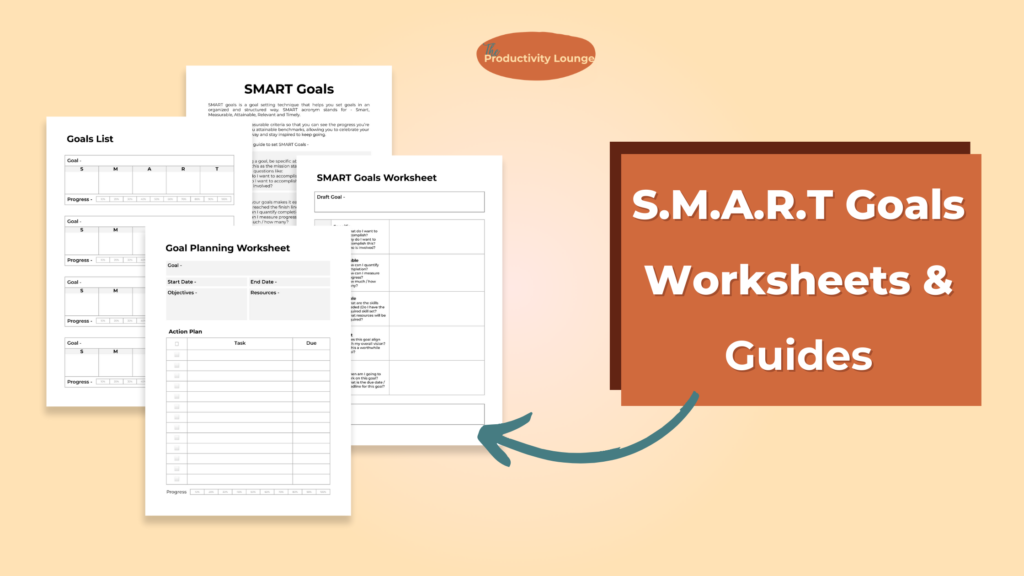Master the Art of SMART Goal Setting: A Step-by-Step Guide to Achieving Success
Introduction: Understanding the Power of SMART Goal Setting
Have you ever set goals for yourself but struggled to actually achieve them? Trust me, I’ve been there too. But then I discovered the magic of SMART goal setting and everything changed.
The benefits of using this technique are incredible. When I started implementing SMART goals in my own life, I noticed a significant increase in my productivity and motivation levels. My goals became more attainable because they were well-defined and had clear action steps associated with them.
SMART stands for Specific, Measurable, Achievable, Relevant, and Time-bound. It’s not just a fancy acronym; each element plays a crucial role in helping you set meaningful and achievable goals. Let’s dive deep and discuss each one in detail so that you have a clear understanding of this goal setting technique.
I have a SMART goals worksheet and a guide to go with it on my Shop. Get the guide by clicking here!

Step 1: Specificity – Define Your Goal with Clarity and Precision
Alright, let’s dive into the first step of setting SMART goals: specificity. When it comes to achieving your goals, being specific is key. You want to be crystal clear about what you want to achieve, who is involved, where it will happen, and when it will take place.
Think of it this way – the more specific you are about your goal, the more fired up and motivated you’ll be to make it happen. So don’t hold back on the details! Whether it’s nailing that promotion at work or running a marathon, get down to the nitty-gritty and paint a vivid picture of what success looks like for you.
I am also sharing a SMART Goals example in the end so that you can have a clear picture of how this works. So stay tuned!
Step 2: Measurability – Establish Concrete Metrics to Track Your Progress
Let’s talk about the “M” in the SMART goal setting technique – measurability. Measurability is a crucial aspect of setting goals because without it, how will you know if you’re making progress?
Having a concrete metric allows you to track your progress and see how far you’ve come. It’s like having a roadmap that shows you the distance between where you started and where you want to be.
So, when setting your goals, make sure to establish a measurable component. Whether it’s tracking the number of sales, website traffic, target weight or a savings number, having something tangible to measure will keep you motivated and provide clear indicators of success.
Step 3: Achievability – Set Realistic and Attainable Goals
The third step in the SMART Goal setting is – “Attainability”. This is where we make sure our goals are not just wild dreams but actually something we can work towards.
To make sure your goal is achievable, you need to break it down into actionable steps. Think about what specific actions you can take to move closer to your goal. By breaking it down, you can create a roadmap that shows you exactly what needs to be done.
Remember, achieving your goals requires effort and commitment. It’s important to set goals that challenge you but are also attainable with the right amount of dedication and hard work.
So, when setting your goals, ask yourself:
- Can I realistically achieve this?
- Can I break it down into actionable steps?
With a clear plan in place, you’ll be well on your way to turning those dreams into reality!
Step 4: Relevance – Align Your Goals with Your Core Values and Objectives
Now that we’ve covered the first three steps of the SMART goal setting technique, it’s time to dive into step 4: Relevance. This step is all about aligning your goals with your core values and objectives.
When setting goals, it’s important to ensure that they are relevant to what you truly want to achieve. Ask yourself, “Does this goal align with my values and long-term objectives?” If the answer is yes, then you’re on the right track.
Relevance is crucial because it helps you stay motivated and focused on what truly matters to you. When your goals are aligned with your core values and objectives, you’ll find it easier to overcome obstacles and stay committed throughout the journey.
Remember, achieving goals is not just about ticking boxes off a checklist. It’s about creating a meaningful impact in your life and aligning your actions with what truly matters to you. So take some time to reflect on your goals and make sure they are relevant to who you are and where you want to go.
Step 5: Time-bound – Define a Clear Timeline for Accomplishing Your Goals
Alright, let’s talk about the “T” in SMART goals – the importance of setting a specific deadline. Remember, a goal without a deadline is just a wish. If you want to achieve your goals, it’s crucial to anchor them to a specific date.
By giving yourself a specific timeframe, you create a sense of urgency and accountability. It helps you stay focused and motivated towards taking action and making progress. Without a deadline, it’s easy for goals to linger indefinitely without any real progress being made.
So, when setting your goals, be sure to attach them with specific dates or timeframes. Whether it’s completing a project or reaching a milestone, having that clear endpoint in mind will keep you on track and increase your chances of success.
Avoiding Common Pitfalls in SMART Goal Setting
Setting SMART goals is a powerful technique for achieving success. However, it’s important to be aware of the common pitfalls that can hinder your progress. By avoiding these mistakes, you can ensure that your goal-setting process remains effective and fruitful.
- Your goals can change with the changing circumstances in your life. It’s important to remember that life is full of unexpected twists and turns. So, don’t be too hard on yourself if your goals need to change along the way. Give yourself some grace and adjust your goals accordingly.
- If you do not achieve a goal in a specified time, give yourself an extension instead of giving up. Remember, the journey towards achieving your goals is just as important as reaching the destination.
By keeping these tips in mind, you can avoid some of the common pitfalls that come with SMART goal setting and stay motivated on your path to success.
Examples of SMART Goal Setting
Fitness Goal:
- Specific: Run a half-marathon in under two hours.
- Measurable: Track running progress with a fitness app and record time improvements.
- Achievable: Start with a 5K, gradually increasing mileage to build endurance.
- Relevant: Aligns with the desire to improve cardiovascular health and overall fitness.
- Time-bound: Participate in a specific half-marathon event in six months.
Career Goal:
- Specific: Attain a professional certification in project management (PMP) within the next year.
- Measurable: Break down study materials into monthly targets and complete practice exams.
- Achievable: Allocate 8-10 hours per week for study while balancing work commitments.
- Relevant: Enhances project management skills, aligning with current job responsibilities.
- Time-bound: Register for the certification exam within three months and complete it within the year.
Financial Goal:
- Specific: Save $10,000 for an emergency fund.
- Measurable: Save $800 per month by setting up automatic transfers to a dedicated savings account.
- Achievable: Cut unnecessary expenses and allocate a portion of monthly income to savings.
- Relevant: Provides a financial safety net for unexpected expenses, contributing to financial stability.
- Time-bound: Achieve the $10,000 savings goal within one year.
Travel Goal:
- Specific: Visit three European countries to explore their culture, history, and cuisine.
- Measurable: Create a detailed itinerary with specific cities and landmarks to visit in each country.
- Achievable: Research and plan a budget-friendly trip, considering available vacation time and financial resources.
- Relevant: Aligns with the desire for cultural enrichment and personal growth through travel experiences.
- Time-bound: Book flights and accommodations within the next three months, with the travel dates set for six months from now.
Personal Development Goal:
- Specific: Improve public speaking skills by participating in a local Toastmasters club.
- Measurable: Attend Toastmasters meetings twice a month, actively participate in speaking opportunities, and track progress through feedback.
- Achievable: Dedicate time each week for speech preparation and practice, starting with shorter speeches and gradually increasing complexity.
- Relevant: Enhances communication skills, which are crucial for professional growth and personal confidence.
- Time-bound: Deliver a five-minute prepared speech at a Toastmasters meeting in two months and progressively work towards more extended and challenging speeches over the next six months.

